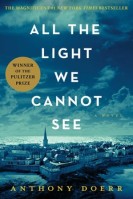Originally posted at Guys Lit Wire. Not the review this book deserves — I could write a paper about the use of symbolism in AtLWCS alone, and I’m sure plenty of English majors will — but I’m fighting off a head cold so it’s the review that it gets. Y’all should read this book.
Boise, ID doesn’t have too many major league celebrities, so it made some pretty big waves when our resident author Anthony Doerr hit the bestseller lists and then proceeded to win the Pulitzer for his second novel, All the Light We Cannot See.
Me, I’m a skeptic. The more hype something gets, the more reluctant I become to jump on the bandwagon. Not only that, but I’ve long betrayed my English major roots by doubting the readability and enjoyability of books that earn major awards. Consequently, I had no immediate plans to pick up the prize-winning WWII novel that everyone in town claimed to be reading until my book club named it as the choice of the month. Even then, I put it off until almost too late, and then began reading immediately to try to beat the clock.
Except… I couldn’t put it down.
All the Light We Cannot See takes place in France as it is occupied by the Nazis, and follows the lives of two children as they grow to young adulthood. The first is Marie-Laure, the French daughter of a locksmith, and the victim of severe cataracts that rob her of her eyesight by the time she is six years old. The second is Werner Pfennig, a German orphan with an uncanny ability to understand machines, which develops into a talent for radio repair that propels him into an exclusive military school for the Nazi elite. Marie-Laure flees Paris with her father, who hides a dangerous secret; Werner becomes a soldier for a cause he doesn’t embrace but lacks the wherewithal to resist. Her fascination with a clandestine radio transmitter, and his obsession with broadcast, tease at intersection.
Finally, inevitably, their paths cross in a French port town in 1944.
This is not a romance, except perhaps in a classical sense. Rather, it is a beautifully-crafted and engrossing window into two aspects of WWII life that most Americans don’t even know that they don’t know. Understanding how the war affected those who were neither Nazi oppressors nor Holocaust victims is priceless, but the truly great thing about this novel is how it lets the reader glimpse the humanity of some of WWII’s monsters. Doerr is no apologist, and in fact the majority of the Nazis he portrays are truly beastly — but Werner’s path toward becoming a Nazi soldier is a tragic and illuminating example of how nice, normal young men got swept up in an inexorable movement.
World War II continues to be a subject of great attraction to young American men, and a much-studied era of history in the schools. Anyone with an interest in this time or this war should take this skeptic’s word for it and run, not walk, to the nearest available copy of All the Light We Cannot See. And that goes for scholars of literature and composition, too — you’d almost think this guy won awards for his writing ability or something.

